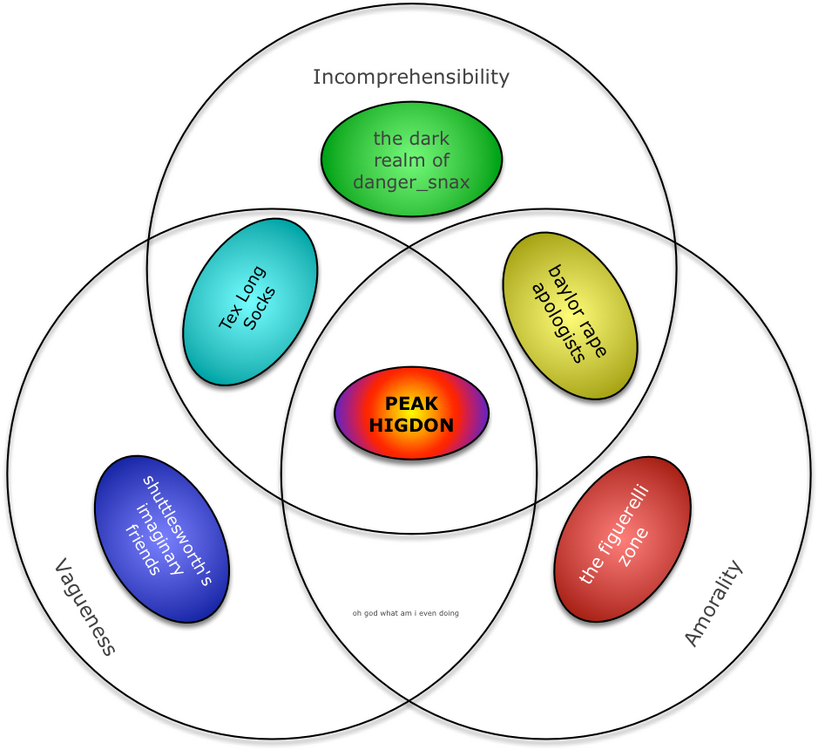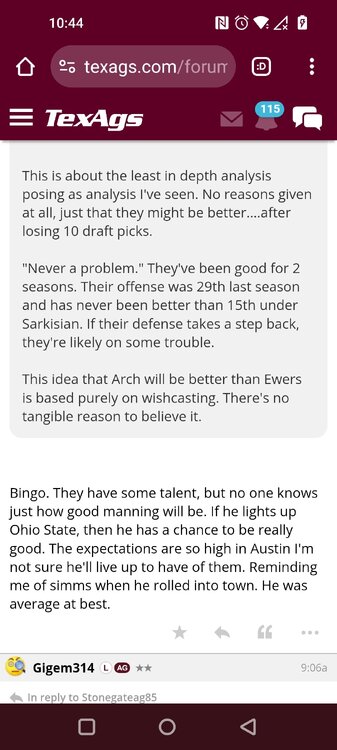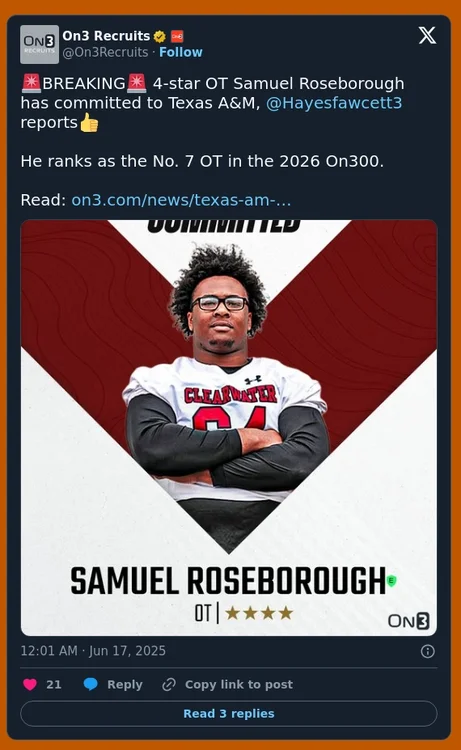-
Posts
15356 -
Joined
-
Days Won
4
Content Type
Profiles
Forums
Store
Downloads
Recruiting - 2020
2019-2020 Football Season
Football
Entertainment
Sports
News and Business
Cloak Room
Transfer Portal
Recruiting
Events
Posts posted by satyanash
-
-
(Justin Wells) Texas Longhorns Recruiting Intel: How the Horns could finish at DT in 2026
QuoteAfter Fort Myers (Fla.) DT Kendall Guervil committed to Florida, Inside Texas take a closer look at UT’s current 2026 defensive line haul and how the Longhorns could finish the cycle. A defensive tackle class of Corey Wells, Vodney Cleveland, and Dylan Berymon is a tremendous foundation for Kenny Baker and the Horns. They’ll look to add one more before the class is done and dusted.
Jaimeon Winfield, DL, Richardson (Texas) – USC commit
This guy has been at the top of UT’s D-line big board for the longest time, and he hasn’t moved from that spot. Despite Winfield “shutting down his recruitment” and no longer taking visits, that hasn’t stopped Baker and the staff from connecting with the four-star on a regular basis. This is a recruitment to watch until he signs in mid-December. Winfield is ranked as the No. 96 overall prospect, the No. 7 defensive lineman, and the No. 15 player in Texas in the On3 Industry Ranking.
Keith Dotie, DL, Mesquite (Texas) Poteet – SMU commit
Texas really liked the SMU pledge when the Longhorns visited Poteet this past spring. So much so that they offered the big Metroplex interior defender. He committed to SMU in late April, however. If Texas finds itself in a position where they have to take four, IT could see the Longhorns kicking the tires on Dotie. Dotie is ranked as the No. 615 overall prospect, the No. 62 defensive lineman, and the No. 93 player in Texas.
Bryce Perry-Wright, DL/EDGE, Buford (Ga.)
More of an EDGE than a DL, Texas is not in the mix for the Peach State product after the Horns took Richard Wesley and remain in a strong position for Jamarion Carlton. Multiple predictions have come in for Perry-Wright to end up at Texas A&M. Perry-Wright is ranked as the No. 33 overall prospect, the No. 5 EDGE, and the No. 5 player in Georgia in the 2026 On3 Industry Ranking.
Lamar Brown, DL, Baton Rouge (La.) University Lab
It was fun while it lasted, but this kid was always going to either LSU or Texas A&M. I’m also sure he was able to drive up his price after his official trip to Austin. Brown is ranked as the No. 7 overall prospect, the No. 1 athlete, and the No. 1 player in Louisiana in the On3 Industry Ranking.
The Late Senior Eval
Texas is always looking at the late senior risers in the recruiting ranks. With the best-case being finding the next Moro Ojomo or unearthing prospects that the Longhorns’ snagged late in the cycle like Warren Roberson and Aaron Butler, Baker and company will look to potentially duplicate that in the trenches in 2026.
-
😆😆😆
Stefan Krajisnik: Ohio State football is set to play within the rules of the new NIL era. Will its rivals do the same?
QuoteThe House settlement, which went into effect Tuesday, is aimed at bringing stability to a world of college athletics known for chaos. As Ohio State athletics director Ross Bjork has repeatedly said, clarity has been delivered. Rules are implemented in areas that seemed lawless during the short name, image and likeness era prior to the settlement’s approval.
One aspect of the approval has come with scrutiny, though, and it’s been a talking point across social media and message boards during a busy time in the college football recruiting cycle. Third-party NIL and how it will be policed during this new era remains hazy. Ohio State, as Bjork noted during an 80-minute press conference last month, is prepared to follow the rules outlined in the House settlement. “There’s a lot of durability built into this that wasn’t necessarily there before,” Bjork said.
The cap for what schools can pay directly to athletes is clear: each athletic department can share up to $20.5 million in revenue, with free reign to divide the money as it pleases. As it pertains to third-party NIL, rules are defined but questions linger. The House settlement comes with the implementation of a clearinghouse, dubbed “NIL Go,” which is run by Deloitte to help the College Sports Commission (a new enforcement entity).
Any third-party NIL agreement of $600 or more must be approved through the clearinghouse. The goal is to determine legitimacy of deals while creating fair market value. Essentially, boosters and collectives can no longer dish out as much money as they want to players just because they can. If an athlete is to earn third-party NIL money, there needs to be a legit purpose — a company paying a player and said player advertising the brand, doing autograph sessions, etc.
Will schools adhere to guidelines if the rules seem difficult to actually enforce? Will punishments actually be handed out if needed? Will lawsuits stem from third-party NIL deals deemed to be illegitimate? Bjork doesn’t think it should be an issue. “The rules of engagement are actually not that complicated when you think about it,” he said.
While Bjork’s stance on following the rules is clear, Michigan has had impressive success on the recruiting trail. The two events happening almost simultaneously has caused a stir among the OSU faithful. Ohio State, which still owns the fifth-ranked 2026 recruiting class, landed just two top-250 players in June. Michigan landed seven such players in the month.
Front-loading has been a trend across the sport, with Opendorse processing more than $20 million in payments to athletes on Monday — the final day before third-party deals had to go through the clearinghouse. Will more loopholes follow during the House settlement? Will the old ways of under-the-table money in college football rear its head? Or, will teams just decide to allocate money differently?
“There’s a lot of studies on this,” Bjork said. “NBA basketball ... they load up on three players and the rest are way below average. How do programs do that? Do they load up on 10 players at key positions? All of this is going to really, really be a thoughtful process.” Ohio State has turned to analytics to determine positional value. The Buckeyes also added defensive coordinator Matt Patricia, who has an extensive NFL background, to the coaching staff. His experience is expected to provide insight into managing a salary cap.
Ultimately, the right approach will prove itself over time — as will the sternness of the third-party NIL enforcement. Ohio State’s approach is to follow the rules outlined, which could still be favorable for a college town located in a relatively large market. “Ohio State football is a built-to-last championship brand,” Bjork said. “That’s not going away.”
-
 5
5
-
-
5 hours ago, GreenspointTexas said:
Could be titled “how DKR rescued OU football”
DKR rejected multiple head coaching offers from blOU after Wilkinson retired (makes sense, no one wanted to be the guy who followed Wilkinson). In some twisted way he probably felt bad and figured he would help his alma mater. Bellard and Akers both tried to talk him out of giving Switzer the keys to the offense, all in vain. DKR later said he regretted the decision after Switzer repaid the favour by spying on his practices.
Switzer refined the wishbone and turned the ground attack aspect of it up to 11. Bryant went the opposite way and improved the passing attack. He first saw the wishbone in action when his Crimson Tide battled the Sooners to a 24-24 tie in the 1970 Bluebonnet Bowl.
-
On 6/27/2025 at 10:18 AM, Sock Monkey said:
There’s 20 recruits committing over the next few weeks, and I’d set the O/U for Texas at 7.5. That’s objectively pretty good, but I’m sure some will feel like the sky is falling with so many “losses” over a short period of time.
...too late to take the under?
-
 1
1
-
 5
5
-
-
- Popular Post
- Popular Post
14 minutes ago, texifornia said:Calicut to Georgia, we're all very sad I'm sure

-
 1
1
-
 9
9
-
-
-
18 minutes ago, SL Xpress said:
It clears up around Corpus Christi.
...at which point the used syringe-to-sand ratio starts becoming unfavourable.
-
 4
4
-
-
- Popular Post
- Popular Post
-
OOTL here, what's the "cannonball" video that's being referenced?
-
On 6/18/2025 at 7:46 PM, Superhero said:
Pretty cool site if want to learn about Omega over the years
Wow, just learned that the Omega Speedmaster went to space? It's amazing Omega doesn't advertise it that much! /s
-
 2
2
-
-
1 hour ago, BurntOrange&White said:
It was actually pretty wild last year that we wanted 4ish DT's last cycle but only brought in 6 OVs or whatever it was.
Last year there was the whole thing with Baker being a new hire, Banks overriding Baker's initial evals at DT and causing confusion.
LB was the position we really mishandled last year. Thank God for Bo Barnes.
-
Eric Nahlin: What a successful 2026 Texas recruiting class would look like
QuoteEvery cycle, I write that a large number of recruits are fungible. That’s not a knock on those players—if they receive a Texas offer, they’re obviously very talented—it’s a reminder the staff will likely have success finding a replacement if the need arises. That leads to this obvious question from rmannucci: “who would you say are the non-fungible recruits for Texas this cycle, other than Dia and Ojo” No capitalization on the first word and no question mark, but he did use a hyphen. What a maniac. Here’s how I see it this year: There is an analog for every top player in the cycle outside of the two five-stars he mentioned. So, I’ll change this pursuit to describing what a successful recruiting class would look like.
Hold on to Dia Bell
Bell is currently showing why he’s the best QB prospect in the country. He’s killing it in a pure passing setting. Real games involve his legs. Stud.
Land Felix Ojo
The current roster is not loaded with obvious future left tackles beyond Trevor Goosby. Ideally, Nick Brooks plays right tackle while Ojo eventually plays left tackle. Ohio State and Michigan are going hard for him. You can’t take anything for granted in this era of recruiting.
Land one of Trenton Henderson or Richard Wesley
Or flip JaReylan McCoy from Florida. The point is, Texas is in pursuit of some elite edge rushers and needs to land one. These guys are Jacks and not the easiest to find, meaning they’re expensive. Both Henderson and Wesley visit this weekend. Time to make a move. Florida leads for Henderson despite having McCoy and Oregon leads for Wesley despite his recent de-commitment from the Ducks.
Find Colin Simmons‘ successor
Dre Quinn announces today. He’s a great option, but IT is increasingly concerned about Clemson. If the staff misses on Quinn, Texas still has Jake Kreul on the board. In addition, Xavier Griffin sort of applies here. Jamarion Carlton might, too.
Capitalize on Anthony Hill‘s career
Texas needs an impact off-ball linebacker in this class. Johnny Nansen missed his numbers in 2024, but at least he converted the Bo Barnes layup. He needs to find another stud to pair with Barnes long-term. That’s either Braydon Rouse or Tyler Atkinson. Texas has an uphill climb. Xavier Griffin sort of applies here, too.
Land at least one of John Turntine, Zaden Krempin, and Malakai Lee
Texas needs more tackles on the roster to develop. The Turntine and A&M threat is real. Don’t sleep on Michigan, either. A&M is also pushing very hard for Krempin. Lee will be at Michigan this weekend. He announces on June 27. Texas is in it after a strong visit. Due to Krempin’s versatility, my hope is they land two from the list.
Four-man defensive tackle class
It would be great if they landed an elite player, obviously, but four good players with easily projectable size and traits would be a very big win. Kenny Baker is already halfway there and is in excellent shape to hit his number this cycle. The current “likely” class will beat the crap out of O-linemen as upperclassmen.
Sign a lead cornerback
The staff might already have one in Jermaine Bishop, and hell, maybe even Hayward Howard, but I want another in the event Bishop ends up at wide receiver. Mark Orphey is in a good position with Samari Matthews and Davon Benjamin.
-
 1
1
-
-
Eric Nahlin: Texas will have another very highly rated class but headwinds need to be navigated
QuoteMy main concern coming into the cycle was how the House settlement would affect things. I was able to get some people on the phone recently that added a bit of clarity on the direction of the class and the sport with a focus on economic factors. Before we get to that, a gentle reminder that Texas is very likely headed for another Top 3 class. As far as House, NIL deals are already supposed to go through NIL Go. Here’s Grok for your reading pleasure:
“NIL Go is a clearinghouse system launched by the College Sports Commission, operated by Deloitte, to oversee and regulate Name, Image, and Likeness (NIL) deals in college sports. It requires all third-party NIL deals worth $600 or more to be submitted for review to ensure compliance with fair market value and compensation standards. The system, which began operations on June 11, 2025, aims to standardize and enforce NIL agreements, using tools like a “compensation range” algorithm and, in some cases, subpoena power during arbitration. It addresses issues like backdoor deals by requiring non-institutional payors to attest to self-funding, though discussions about potential loopholes persist.”
That date, June 11, is important. Any contracts executed now have to go through compliance. Accordingly, Texas is already running deals through NIL Go. Is everyone else? Is USC about run Luke Wafle‘s deal through compliance? Probably so, or at least parts of the deal, given how public that recruitment is but I don’t know. As it was relayed to me, the Commission needs to make a big time example out of a couple of schools, which indicates there are a few schools coloring outside the lines. That’s a “no duh” statement but something to remain aware of. Right now there is no fear when it comes to cheating, just business as usual. The whole point of appointing Bryan Seeley was to make sure everything stays on the level. Of course there will be lawsuits against any rules that limit how players earn but that’s a whole other can of worms.
A source thinks this class, or perhaps the next one, is the last hurrah for NIL as we know it. Going forward, the best players and prospects will still get paid but everyone else will be on salary. Under-the-table payments are a legitimate consideration but bag money is nowhere near as expensive as collective generated NIL. Prices will moderate. So, where does Texas sit in this cycle when it comes to economics? Finances are fine, but the same things that were written last July still hold true. Steve Sarkisian and his staff are going to play the long game in order to not bid against themselves. Texas typically knows exactly how much a player is offered from a school and often they don’t think that school will follow through, or the school is offering way too much.
I told a source recently there were similarities to the 2022 and 2025 cycle right now and he replied, somewhat mockingly, “Yes, I heard this last year. Around this time.” I relayed I have zero concerns but have readers I’d like to keep apprised of the situation. The biggest issue he said is the current Texas roster. When combining what he said with another really good source, the roster affects this class in two ways: Some recruits see a loaded position room and don’t want to wait to play, and the coaches see a loaded roster and don’t want to overpay for someone who is going to ride the pine. Running back KJ Edwards is the embodiment of these two points, though I’ll also add the Aggies did a good job of recruiting him. I think this class is headed for a mix of cheaper developmental prospects and more expensive elite players at positions of need or priority.
-
 2
2
-
-
40 minutes ago, Pato del Muerto said:
And that’s called a budget. Which these programs have.
There's a fundamental asymmetry to losing a NIL recruitment vs. winning one. You have to outspend many schools to win a recruitment, but it takes just one school outspending you to lose a recruitment. For Edwards it was A&M. For Bowman it was USC. For Lott it will be Oregon. For Atkinson it will be Georgia. We can certainly pride ourselves on not overspending, but whether we finish in 2nd place for a recruit or whether we never even pursue the end result is still the same.
Yes, you can say A&M/USC/Oregon/Georgia/Ohio State are stupid for overspending and that we'll ultimately benefit. But teams can now pick and choose which recruits to overspend on, knowing that the House settlement has freed up a lot of additional funding and scholarship limits are much looser. For each of them it's one recruitment won, with a decreased chance of winning future recruitments that we or other unaffected schools may or may not be involved in. But for us it's already four big recruitments lost and counting. We're trading concrete, known losses for the hope of nebulous, hypothetical future recruiting wins.
-
 2
2
-
 4
4
-
-
3 minutes ago, Elmer_Fudd said:
All the tOSU picks for Luke Wafle yesterday have been changed to USC this morning.
Steve Wiltfong: Moving the prediction to USC for prized edge rusher Luke Wafle
QuoteHun School (NJ) On300 edge rusher Luke Wafle is set to announce his college decision on Thursday at 2 pm. It can be viewed on the On3 Recruits YouTube Channel. This has been a back-and-forth bidding war between USC and Ohio State. I liked the Trojans coming out of the official visit over the weekend. I then picked the Buckeyes to win this recruitment by Wednesday morning. Now, the Trojans battled back early Wednesday evening.
Now I’m predicting USC wins this recruitment in the end. Both programs over the last 48 hours upped their NIL packages and as reported yesterday sources are indicating Wafle is tracking to be the next prospect to have a deal of at least a million dollars per year. We’re hearing now a two-year deal worth between 2.2 and 2.6 million dollars is the range.
A spring visit to Ohio State and then a summer official visit checked a lot of boxes for Wafle from a development and culture standpoint. Whatever the NIL promise was, USC trumped it this past weekend. That along with potentially playing for Eric Henderson and Shaun Nua also made for an exciting opportunity. Ohio State then trumped that NIL offer. Now USC is in control again for what has become a bidding war for one of America’s best.
Ryan Day and the Buckeyes will keep in touch throughout the day so we’ll see what happens. The On3 Industry tabs Wafle as the nation’s No. 10 edge and No. 52 prospect overall. On3 slots him at No. 4 edge and No. 14 nationally. USC currently has the nation’s No. 1 class and even canceled a visit of another prospect this weekend after Wafle was trending their way. Ohio State has the No. 4 class.
There might not be a prospect higher on the board this entire cycle for the Buckeyes than Wafle. Florida, Penn State and Texas round out the top five for Wafle.
-
 1
1
-
 1
1
-
-
(Nicole Auerbach) Table the expansion talk: The College Football Playoff should stay at 12 teams
QuoteAnother day, another college commissioners’ meeting — and another conversation about potential College Football Playoff expansion that has ended without resolution. Or, as I like to put it, just your typical Wednesday in June. “Pretty much everything’s on the table and they’re taking a good look at all of it,” CFP executive director Rich Clark told reporters in Asheville, N.C. “So I wouldn’t say there’s a leading contender right now for them, but they’re taking a fresh look at it.”
Round and round we go on a topic that never seems to go away completely. Even though there’s an easy (if boring) solution: The CFP should stay as is — at 12 teams. Now, I get why there’s always at least one loud voice clamoring to expand the field. College football is a sport that has crowned its champion by polls and by computer algorithm. There’s always been incredible interest in a playoff model, even when college football didn’t have one. Then we got a four-team bracket, approved in 2012 and implemented in time for the 2014 season.
Just one year into the 12-team era, commissioners now demand further expansion. The Big Ten has pushed for a 16-team bracket with multiple automatic qualifiers (AQs) per league, with the Big Ten and SEC each nabbing four designated spots — the so-called 4-4-2-2-1 model, which grants them double the number of AQs of the ACC and Big 12 with one spot designated for the highest-ranked Group of 5 champion.
The SEC stunned those in Big Ten circles with its coaches publicly pushing for a 5+11 model — one AQ per league and the Group of 5, with 11 at-large spots — at its spring meetings last month. The SEC’s interest in the 5+11 model aligns well with what’s best for both the ACC and Big 12, two leagues that did not want to accept a model that essentially defined them as second-tier conferences.
The posturing and preening over the past month has left the sport in a messy spot. It’s also uncharted territory, because any format changes made for the 2026-27 season do not require unanimity. Changes do require the Big Ten and SEC to agree on them, though, and the relationship between the two is in a far more tenuous place than it was six weeks ago. Multiple sources in the Big Ten have told NBC Sports that the conference will not support the 5+11 model if the SEC remains at eight conference games. (The Big Ten plays nine.) As the CFP expansion debate stretches further into the doldrums of the summer, even the Big Ten’s coaches are jumping into the fray.
It is quite possible that the current Big Ten-SEC standoff delays or stymies bracket expansion. Any format changes for the 2026-27 season need to be decided on and communicated to ESPN by Dec. 1. But if the Big Ten and SEC can’t come to an agreement on a specific 16-team format by that date, the expectation is that the Playoff would simply move forward in its current iteration — with 12 total teams, including five conference champions and seven at-large selections. And, frankly, that is the best possible outcome.
The 12-team CFP worked out exceptionally well in its first year. More teams had access to the sport’s premier postseason than ever before, which meant dozens of teams that previously would have been eliminated were still fighting for spots in the final weeks of the regular season. Increased access led to increased engagement by fans. First-round games on campus were as electric as we had hoped they would be. Even early round blowouts turned out to be a blessing in disguise, as they set up some great quarterfinal games and excellent, evenly matched semifinals.
Even with just one season’s worth of data, it’s clear that there aren’t actually going to be 12 teams truly capable of winning a national title, that there are perhaps only six to eight built to get to the finish line. But it is obvious, too, that the very best teams in college football will fall within the 12 teams picked to participate year in and year out. Teams No. 13 or 14, on the wrong side of the cut line, were flawed teams that had lost to lesser opponents multiple times. The first team out of any field will always complain, but that exclusion felt far different from the Bowl Championship System era or even the four-team bracket days. In the past, we all worried that the best team in the country might not have a chance to play for a national championship. That’s no longer a fear in a 12-team world, because the buffer is so wide.
The only real problem with Year 1 of the 12-team CFP era was the way its convoluted seeding system worked — and that issue got fixed this offseason. Straight seeding 1-12 means a balanced bracket, and it also means that the four best teams (per the selection committee) are the four teams that get first-round byes. That is how the system should work, and it will give us more competitive, evenly matched early-round games.
The 12-team format worked well, and it’s going to work even better with straight seeding. But this sport’s leaders are impatient; they started discussing expanding beyond 12 teams before a single CFP game was played last winter. They assume bigger is better just because. Their bloated leagues need more access points, so they like the idea of 16 more than they do 12, even if the status quo is a pretty great solution to the problems that have ailed college football. The current format is fundamentally fair, and it will help the sport continue to evolve from its regional roots to its status as a national behemoth.
Ultimately, the Big Ten and SEC will surely figure out a way to work together again. The current standstill may just be a momentary (fortuitous?) blip. But while we’re here and while we’re paused, I hope the sport’s leaders take a second to look around. The grass isn’t always greener someplace else. Sometimes, it’s best to stay put.
-
 1
1
-
-
18 hours ago, BlackCat said:
Per someone writing the checks we are upping the bid on Atkinson and several others. He’s not gonna end up here but others will have to pay. We are managing things on a high level and even in recruitments we aren’t likely to win we are a big fucking problem for everyone else out there. It’s a fantastic time to be a Texas fan. I’m enjoying it immensely. Once it officially became a game of money and intelligence we rose to the top in a hurry. Fun times.
"He's not gonna end up here but others will have to pay. It’s a fantastic time to be a Texas fan."
This is TexAgs-level moral victory rationalizing. It's up there with "we didn't land the kid, but at least him going to [insert big program here] proves our coaches can evaluate" from the Strong days. And I guess it's going to be repeated ad nauseum once we lose Perry-Wright and Turntine the same way we lost Edwards.
And I don't know why we're even talking about Wafle. USC and Ohio State are offering him two-year, $2.5 million NIL deals and he's going to one of those schools. But I guess they had to get in a bidding war so it's actually fantastic for us, or something.
-
 2
2
-
 2
2
-
-
12 minutes ago, texifornia said:
Who uses the Studio Ghibli AI filter for football photographs?
And why the fuck does the Texas jersey have an Adidas logo, orange pants and orange helmet?
-
 1
1
-
-
-
3 minutes ago, HtownHorn said:
Did Wisconsin join the SEC in the offseason?
Those are rankings for all FBS schools. Wisconsin is the only non-SEC team in the top 15, because they play Alabama in Tuscaloosa this year.
-
 1
1
-
-
2 hours ago, closetojumping said:
How many paint chips does one have to consume in order to look at the Texas 2025 schedule and say out loud "yeah, that's an easy schedule"? These posters are a special form of stupid.
SoS rankings for 2025:
- Florida
- Vanderbilt
- Oklahoma
- Texas
- Arkansas
- Mississippi State
- Kentucky
- Georgia
- Texas A&M
- Alabama
- Louisiana State
- Wisconsin
- South Carolina
- Auburn
- Tennessee
-
 1
1
-
- Popular Post
-









Texas Recruiting Notes 2026: Boulevard of Broken Bagmen
in 🤫$9.95🤫
Posted
https://www.nytimes.com/athletic/6414771/2025/06/10/nil-house-settlement-paying-athletes-deals-ncaa/
The new enforcement terms under the House settlement instruct college athletes to declare any third-party NIL deals worth at least $600 into a clearinghouse database. The idea is that the clearinghouse, dubbed “NIL Go” and managed by the accounting firm Deloitte, will serve as a restrictor plate on NIL collectives and pay-for-play, flagging deals that do not reflect a valid business purpose or fall within a reasonable range of compensation. Yahoo Sports reported that at the recent ACC spring meetings, Deloitte officials shared that 70 percent of past deals from NIL collectives would be denied under the new clearinghouse.
But in candid conversations, coaches and recruiting staffers have serious doubts that athletes will declare those deals, or do so accurately. Some have suggested that players are being encouraged not to declare deals at all, but to simply take the money and keep quiet rather than risk the clearinghouse flagging it. And if that’s the case, where do we suspect that money might be coming from? “I guess it would just be the same as the way things used to work,” lamented the athletic director, frustrated by those already angling to undermine the settlement. “We’d be right back where we started.”
History suggests that power-thirsty boosters paying athletes under the table is a tough thing to police — particularly after collectives spent the past few years streamlining the art of bag dropping. Now, instead of an envelope of cash in a player’s locker, it’s a direct deposit into their bank account. (The IRS might complicate that process under the House settlement, but that’s what payment apps are for.) “If some donor wants to wire a player $25,000 a month, who’s keeping track of that?” one power conference administrator said. Money wires aside, the system of boosters paying players is much more sophisticated and far less frowned upon, and it’s going to be impossible to put that infrastructure back into the tube.